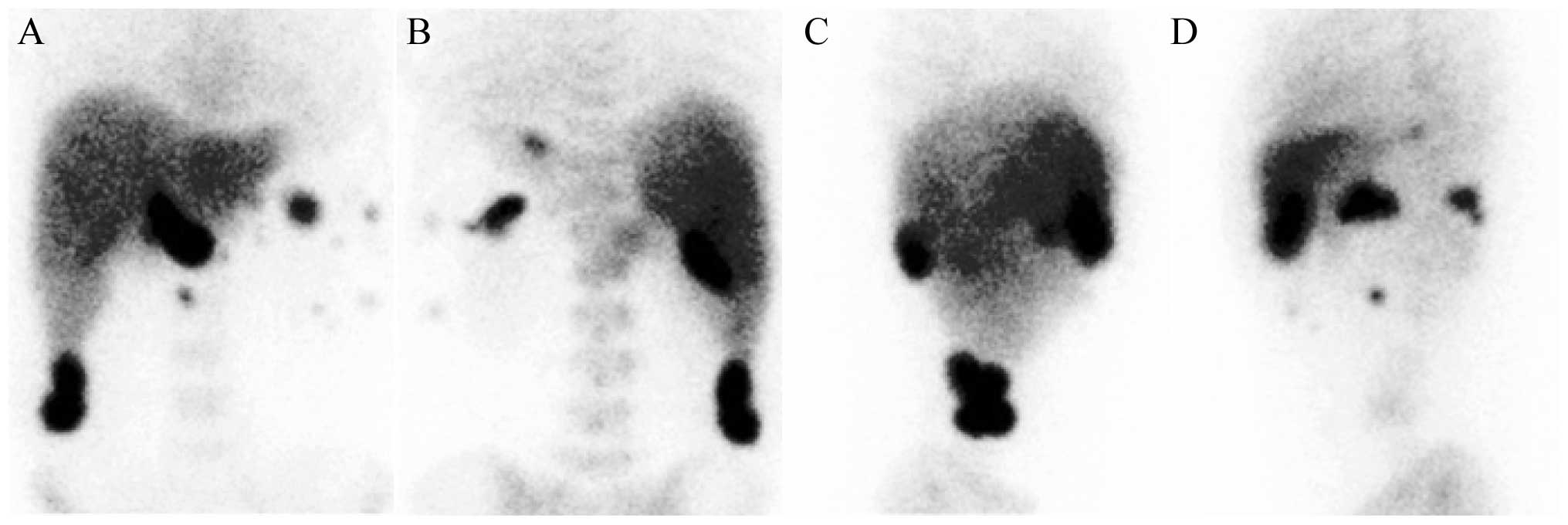Ectopic splenic autotransplantation following traumatic injury: A case report
- Authors:
- Published online on: September 7, 2015 https://doi.org/10.3892/etm.2015.2732
- Pages: 1973-1975
Abstract
Introduction
Ectopic splenic autotransplantation (ESAT) following splenectomy or trauma may occasionally be encountered in clinical practice; however, clinicians or general radiology practitioners often find the diagnosis of this condition challenging (1–4). The majority of ESAT cases have no clinical symptoms and it is difficult to diagnose the exact incidence rate. Computed tomography (CT), ultrasound or magnetic resonance imaging are not specifically designed for the diagnosis of ESAT, and certain patients are misdiagnosed and undergo surgery. However, radionuclide spleen imaging has the potential of being a more specific diagnostic method for ESAT and may avert surgery. The present study reports a case of ESAT, which was diagnosed using radionuclide splenic imaging. Written informed consent was obtained from all participants.
Case report
A 41-year-old male patient was admitted to the General Hospital of Guangzhou Military Command (Guangzhou, China) due to upper abdominal pain persisting for 12 h. The patient had been involved in a traffic collision and had undergone a splenic resection 10 years prior, which were hypothesized to have been associated with the symptoms. Physical examination revealed a 15-cm longitudinal and transverse operational incision scar, abdominal tenderness and rebound tenderness, with a negative Murphys sign.
Laboratory examination
The laboratory examination results were as follows: White blood cell count, 2.1×1010 cells/l; neutrophils, 84.6%; serum amylase, 246 U/l; serum lipase, 407 U/l; carcinoembryonic antigen, 2.27 g/ml; α-fetoprotein, 6.17 mg/l; and CA199, 22.47 U/ml. These results were within normal ranges, indicating that it was unlikely that the patients symptoms were tumor-related.
Positron emission tomography (PET)/CT scanning
The CT scan showed that the patient suffered from acute pancreatitis, severe fatty liver and small gallstones, and there were foci in S3 and S6 of the liver and multiple space-occupying foci in the ascending colon. The PET/CT scan showed the following: i) Multiple soft-tissue shadows in the abdominal cavity, peritoneum and Glisson's capsule, which were suggested to be benign lesions, since no metabolic disorder was observed; ii) a small area of low-density shadows near the tail of the pancreas, which was considered to be inflammation, since the metabolic activity was mildly increased in that area; iii) multiple shadows of enlarged lymph nodes around the porta hepatis and pancreas, with a mildly increased metabolic activity; iv) absence of the spleen, since splenectomy had been performed (Fig. 1).
Radionuclide imaging
The spleen was absent from its normal position (following splenectomy), but abnormal phagocytosis of multiple red blood cells was observed in the abdomen, which was considered to be ESAT (Fig. 2).
Clinical diagnosis
The patient was diagnosed with acute pancreatitis, cholecystitis with gallstones, fatty liver and ESAT following splenectomy. The patient subsequently recovered well after receiving antipyretic analgesics and rehydration therapy..
Discussion
ESAT refers to the spontaneous transplantation of splenic tissue following injury or splenectomy. ESAT may occur in various sites, such as the chest, pelvic cavity or subcutaneous tissue, but is mainly found in the abdominal cavity (5–7). In the majority of cases, ESAT is asymptomatic and does not affect any physiological function; therefore, intervention is usually not required (8). In the present case, the patient presented with acute pancreatitis and ESAT was detected accidentally; it did, however, affect clinical diagnosis to a great extent, as ESAT is easily misdiagnosed as a tumor. Conventional radionuclide splenic imaging is a method specific for the diagnosis of ESAT, and in the present case it proved to be more diagnostically significant compared with PET/CT.
References
|
Oda J, Tachikawa N and Suda T: A solid mass in pelvic region. Gastroenterology. 137:e9–e10. 2009. View Article : Google Scholar : PubMed/NCBI | |
|
Wallace S, Herer E, Kiraly J, Valikangas E and Rahmani R: A wandering spleen: Unusual cause of a pelvic mass. Obstet Gynecol. 112:478–480. 2008. View Article : Google Scholar : PubMed/NCBI | |
|
Fiquet-Francois C, Belouadah M, Ludot H, et al: Wandering spleen in children: Multicenter retrospective study. J Pediatr Surg. 45:1519–1524. 2010. View Article : Google Scholar : PubMed/NCBI | |
|
Bouassida M, Sassi S, Chtourou MF, et al: A wandering spleen presenting as a hypogastric mass: Case report. Pan Afr Med. J11:312012. | |
|
Di Crosta I, Inserra A, Gil CP, Pisani M and Ponticelli A: Abdominal pain and wandering spleen in young children: The importance of an early diagnosis. J Pediatr Surg. 44:1446–1449. 2009. View Article : Google Scholar : PubMed/NCBI | |
|
Dirican A, Burak I, Ara C, Unal B, Ozgor D and Meydanli MM: Torsion of wandering spleen. Bratisl Lek Listy. 110:723–725. 2009.PubMed/NCBI | |
|
Tseng CA and Chou AL: Images in clinical medicine. Pelvic spleen. N Engl J Med. 361:12912009. View Article : Google Scholar : PubMed/NCBI | |
|
Dillman JR and Strouse PJ: Clinical image. The ‘wandering’ spleen. Pediatr Radiol. 40:2312010. View Article : Google Scholar : PubMed/NCBI |











